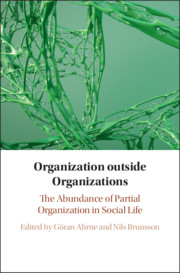Book contents
- Organization outside Organizations
- Organization outside Organizations
- Copyright page
- Contents
- Preface
- Contributors
- Introduction
- Part 1 Rules, Sanctions, Membership
- Part 2 Organization in and around Markets
- Part 3 Networks and Other Social Relationships
- Part 4 Social Movements and Collective Action
- Part 5 The Partial Organization of Formal Organizations
- Conclusion
- Index
- References
Part 5 - The Partial Organization of Formal Organizations
Published online by Cambridge University Press: 11 July 2019
- Organization outside Organizations
- Organization outside Organizations
- Copyright page
- Contents
- Preface
- Contributors
- Introduction
- Part 1 Rules, Sanctions, Membership
- Part 2 Organization in and around Markets
- Part 3 Networks and Other Social Relationships
- Part 4 Social Movements and Collective Action
- Part 5 The Partial Organization of Formal Organizations
- Conclusion
- Index
- References
Summary
The idea of partial organization has not been fully explored. Relatively little attention has been paid to organization within organizations or to the possibility of partial de-organization. We explore this possibility in the context of business firms for which innovation and strategic renewal are imperatives. The firm’s top management created conditions for autonomous action in the form of a dedicated internal development program for strategic renewal. Thus, it attempted to partially deconstruct its organizational hierarchy and other elements of its decided order. Employees from all over the organization were invited to participate in the program and to present proposals for new strategic initiatives. The contribution of the paper is in the introduction of the concept of partial de-organizing and in the argument that partial organization is also observable within, and not just without, the boundaries of formal organizations.
Keywords
- Type
- Chapter
- Information
- Organization outside OrganizationsThe Abundance of Partial Organization in Social Life, pp. 357 - 418Publisher: Cambridge University PressPrint publication year: 2019



